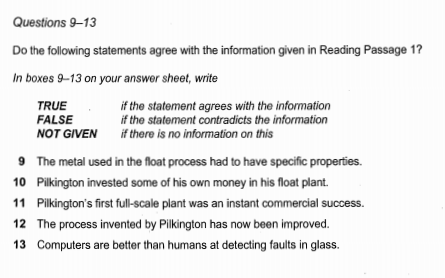剑桥雅思8阅读:Test2雅思阅读PASSAGE 1真题+答案+解析
发布时间:2020-12-07 关键词:READING
READING PASSAGE 1
You should spend about 20 minutes on Questions 1-13, which are based on ReadingPassage 1 below.
Sheet glass manufacture:the float process
Glass, which has been made since the time of the Mesopotamians and Egyptians, is lttle morethan a mixture of sand, soda ash and lime. When heated to about 1500 degrees Celsius (C)this becomes a molten mass that hardens when slowly cooled. The first successful methodfor making dear, flat glass involved spinning. This method was very ffective as the glasshad not touched any surfaces between being soft and becoming hard, so it stayed perfectlyunblemished, with a 'fire finish". However, the process took a long time and was labour
intensive.
Nevertheless, demand for flat glass was very high and glassmakers across the world werelooking for a method of making it continuously. The first continuous ribbon process involvedsqueezing molten glass through two hot rollers, similar to an old mangle. This allowed glass ofvirtually any thickness to be made non-stop, but the rollers would leave both sides of the glassmarked, and these would then need to be ground and polished. This part of the process rubbedaway around 20 per cent of the glass, and the machines were very expensive.
The float process for making flat glass was invented by Alistair Pilkington. This processallows the manufacture of clear, tinted and coated glass for buildings, and clear and tintedglass for vehicles. Pilkington had been experimenting with improving the melting process,and in 1952 he had the idea of using a bed of molten metal to form the flar glass, eliminatingaltogether the need for ollers within the float bath. The metal had to melt a a temperatureless than the hardening point of glass (about 600C, but could net boil at a temperaturebelow the temperature of the molten glass (about 1500"C). The best metal for the job wastin.
The rest of the concept relied on gravity, which guaranteed that the surface of the moltenmetal was perfectly flat and horizontal. Consequently, when pouring molten glass onto themolten tin, the underside of the glass would also be perfectly flat. If the glass were kept hotenough, it would flow over the molten tin until the top surface was also flat, horizontal andperfectly parallel to the bottom surface. Once the glass cooled to 604C or less it was too
hard to mark and could be transported out of the cooling zone by rollers, The glass settled toa thickness of six millii beciuse of surface tension interactions between the glass andthe tin. By fortunate coincidence, 60 per cent of the flat glass market at that time was for six-millimetre glass.
Pilkington built a pilot plant in 1953 and by 1955 he had convinced his company to buildafull-salea plant. However, it took 14 months of non-stop production, costing the compunyE100.000a month, before the plant produced any usable glass. Furthermore, once they
sucoeeded in making marketable flat glass, the machine was turned off for a service to prepareit for years of continuous production. When it started up again it took another four months toget the process right again. They fnally scceeded in 1959 and there are now float plants allover the world, with each able to produce around 1000 tons of glass every day, non-stop foraround 15 years.
Float plants today make glass of near optical qualiry. Several process - melting refininghomogenising - take place simultaneously in the 2000 tonnes of molten glass in the furnace.They occur in separate zones in a complex glass flow driven by high temperatures. It adds upto a continuous meling process, lasting as long as 50 hours, that delivers glass smoothly andcontinuously to the float bath, and from there to a coating zone and finally a heat treatmentzone, where stresses formed during cooling are relieved.
The principle of float glass is unchanged since the 1950s. However, the product has changeddramatically, from a single thickness of 6.8 mm to a range from sub-illimetre to 25 mm,from a ribbon frequently marred by inclusions and bubbles to almost optical perfection. Toensure the highest quality, inspection takes place at every stage. Occasionally, a bubble is notremoved during refining. a sand grain refuses to melt, a tremor in the tin puits ripples intothe glass nibbon. Automated on-line inspection does two things. Firstly, it reveals processfauls upstream that an be corrected. Inspection technology alows more than 100 millionmeasurements a second to be made across the ribbon, locating flaws the unaided eye would beunable to see. Secondly, it enables computers downstream to steer cutters around flaws.
Float glass is sold by the square metre, and at the final stage computers translate customerrequirements into patterns of cuts designed to minimise waste.
PASSAGE 1 参考译文:
玻璃板制造:浮法工艺
早在美索不达米亚时期和古埃及时期人们就开始制造玻璃,当时制作出的玻璃只不过是沙子、碳酸钠 和石灰的混合物而已。该混合物被加热到约1500摄氏度时会变成熔质,慢慢冷却后会硬化。最早成功制出透明、平整的玻璃的工艺中包括旋制法。该制法有效,因为玻璃在由软变硬的过程中不会接触任何表面,因此可以一直保持完美无瑕的状态,最后通过“火处理”收尾。然而,该过程耗时很长,而且要耗费大量的劳动力。
尽管如此,人们对平整玻璃的需求很高,全世界的玻璃制造者都在寻找可以连续制造玻璃的方法。个连续带式工艺过程是用两个高温滚轴挤压熔化的玻璃——类似老式的轧板机。该工艺可以连续不断地制造几乎各种厚度的玻璃,但是滚轴会在玻璃板的两面都留下痕迹,这就需要对玻璃进行打磨和抛光。这一过程会磨去约20%的玻璃,而且所用的机器也很昂贵。
Alistair Pilkington发明了浮法玻璃制造工艺。该制法可以用来制造用于建筑物上的透明、有色的加膜玻璃,也可以为车辆提供透明的有色玻璃。Pilkington 一直在反复实验,研究如何改良熔化工艺。在1952年,他 萌生了用熔化金属作基床加工玻璃板的想法,有了这样的金属液槽,就可以彻底淘汰滚轴了。该金属的熔点必须低于玻璃的硬化温度(约600摄氏度),但同时沸点要高于熔化玻璃的温度(约1500摄氏度)。这些条件的金属是锡。
实现这一想法的另一个条件就是重力。重力可以保证熔化金属的表面完全平整且水平。因此,把熔化的玻璃浇在熔锡上时,玻璃的下表面也会完全平整。如果玻璃能够保持足够的高温,它就会在熔锡上慢慢流动,直到其上表面也平整、水平,并与下表面完全平行。一旦将玻璃冷却至604摄氏度或更低,玻璃就会 硬化到表面不会被刮花的程度,这样就可以通过滚轴将其运送到冷却槽了。玻璃和锡的表面张力相互作用会使成形的玻璃板的厚度稳定在6毫米。幸运的巧合是,当时市场对玻璃板的需求有60%是6毫米玻璃板。
1953年,Pilkington建立了一个试点工厂。到1955年为止,他已经说服他的公司建立成套的工业装置。然而,他们经过14个月的不间断生产且每个月花费10万英镑,才在厂里生产出可用的玻璃。而且,他们 在成功生产出能投人市场的玻璃之后,就将机器关闭了,为的是在接下来几年能够持续生产。当机器再次投人生产时,又花了四个月的时间来使生产流程走上正轨。1959年,他们终于成功了。如今浮法制玻工厂遍布全球,每一个工厂都能够15年不间断地日产玻璃千吨。
今天的浮法制玻工厂可以生产出接近光学质量的玻璃。在容纳了2000吨熔化玻璃的熔炉内,同时进行着多个程序——溶化、精炼、均质化。这些过程发生在由高温驱动的熔化玻璃流的不同区域,并汇总成为一个长达50小时的无间断熔炼过程,向金属液槽平稳、连续地提供玻璃。接着玻璃会被送往加膜区,最后 会被送达热处理区——该区域能够缓释玻璃内部在冷却过程中产生的应力。
自20世纪50年代以来,浮法制玻的原理不曾改变过。然而,玻璃制品却经历了巨大变化:从之前单一的6.8毫米玻璃板到如今的亚毫米级至25毫米区间任意厚度的玻璃板;从之前很容易被内含物和气泡损毁 的玻璃带到如今接近光学完美的玻璃。为了保证质量,每一个生产阶段都有监察。偶尔,在精炼过程中 也会有一个气泡未被排出,一颗沙粒没有熔化,或是液锡的波动导致玻璃带产生波纹等情况。自动的在线监察有两项任务:一是向上游(生产前阶段)报告生产过程中可以修正的纰漏。监察技术可以在玻璃带上实 现每秒超过一亿次的测量,以定位肉眼无法辨认的瑕疵;二是让下游(生产后阶段)计算机操控刀具切割掉有瑕疵的部分。
浮法玻璃是按平方米出售的。在生产的最后阶段,计算机会根据顾客的需求设计玻璃的裁割方案,以实现浪费的最小化。


师资点题剑桥雅思8阅读:
体裁:说明文
主要内容:平板玻璃的制造发展历史。
结构:
第 1 段:最早的平板玻璃制作方法 :抽丝法。
第 2 段:持续制造平板玻璃的另一种方法 :带状法。
第 3 段:浮法玻璃制造法。
第 4 段:浮法玻璃制造过程。
第 5 段:浮法玻璃制造方法投入生产终至成功。
第 6 段:浮法玻璃制造过程在现代得到改良。
第 7 段:现代技术在生产过程的应用,产品质量大大。
第 8 段:浮法玻璃切割由技术控制。
师资点题剑桥雅思8阅读:
Questions 1-5 ● 题型归类:Table
题目编号 题目定位词 答案位置 题解
1 method 段第 4行 由题目可知,本题需填入一种 method 的名 称。可通过 method 一词定位至文章第 1 段第 3 行。通过 The first successful method for making clear, flat glass involved spinning 可知本题答案 为 spinning。
2 glass , remained 段倒 数第 2 行 由题目可知,本题需填入形容玻璃的形容 词。可沿上道题目的答案按照逻辑关系继 续向后寻找。答案所在句为 ...so it stayed perfectly unblemished。本题答案为 (perfectly) unblemished。
3 disadvantages, slow 段最 后1句 由题目中的 disadvantages 找到文章中表示意思 与上文相反或相对的强转折词 However。同时 根据 slow 判断本题需填入与之并列的形容词。 通过段最后一句可确定本题答案为 labour- intensive。
4 ribbon, varying 第二段第 4行 根据 ribbon 定位至文章第二段第 2 行,根据 non-stop 可知答案应出现在文章第二段第 4 行 之前。再由题目可判断本题需填入一抽象名词, 与 of 构成短语相当于一个形容词。通过原文 This allowed glass of virtually any thickness to be made non-stop 可知本题答案为 thickness,其中 句中的 any 与题目中的 varying 是同义替换。
5 disadvantages, 20% 第二段倒 数第 2 行 由题目可判断本题需填入一个形容词,且答案 应出现在第二段最后 1 行的 20% 之前。按照逻 辑关系找到修饰 glass 的形容词即可。本题答案 为 marked。
师资点题剑桥雅思8阅读:
Questions 6-8 ● 题型归类:Diagram
师资点题剑桥雅思8阅读:
题目解析 可先通过图中的 cooling zone 一词定位至文章第四段倒数第 4 行。
题目编号 答案位置 题解
6 第四段第 2行 由图可知本题需填入进入 melting zone 的指代某种液体的名词。 由原文 when pouring molten glass onto the molten tin 可知本题 答案为 molten glass。
7 第四段第 3行 由图可知本题需填入题目 6 所指代液体进入的区域名称。通过 解答上一题很容易可以判断出本题答案为 molten tin/metal。
8 第四段倒数
第4行 由图可知本题需填入表示轮状物体的名称。顺着第 7 题的答案 继续向下阅读,通过原文 ...and could be transported out of the cooling zone by rollers 可知本题答案为 rollers。
师资点题剑桥雅思8阅读:
考题解析 Questions 9-13
● 题型归类:TRUE/FALSE/NOT GIVEN 本题型可先看题目,将其中关键词划出,回到文章查找相关信息。如果关键词只进行了同义 替换,而逻辑未发生改变,则句子为 TRUE;如果关键词中有一个词性质错误或者意义相反, 则为 FALSE;如果关键词有一个消失,则为 NOT GIVEN。
师资点题剑桥雅思8阅读:
题目解析
题目编号 题目定位词 考点 答案位置 题解
9 metal, float process specific properties 第三段倒数 第2句 TRUE 因为上一道题的题型 diagram 和 本 类 题 型 TRUE/ FALSE/NOT GIVEN 都 是 按 照 文章顺序出题,本题可沿上道题 的答案继续寻找。题目中 specific properties 是文章中第三段倒数第 2 句内容的抽象概括。
10 Pilkington, plant his own money 第五段第 1 句 NOT GIVEN 通过题目中的人 名和 plant 一词定位至文章第五段 第 1 句,但句子中并未出现与 his own money 相关信息,因此无法判 定题目表述是否正确。
11 Pilkington’s first full- scale plant instant commercial success 第五段最后 一句 FALSE 通过题目中的专有名词和 具体名词 plant 定位到文章第五段 第 1 句。由第 2 句句首的强转折 词 However 可知,情况向相反的 方向发生变化。此后的句子则具体 说明成功路上的各种阻碍,在最后 一句中看到最终取得成功的时间 是 1959 年,与题目中表述 instant commercial success 相反。
12 process, now improved 第六段 TRUE 由题目中 now 一词定位至 文章第六段第 1 句,本段的内容是 process improved 的具体表现。所 以题目表述与原文相符,表述正确。
13 computers, humans better...at detecting faults 第七段倒数 第2行 TRUE 当句子中出现比较级时, 可通过进行比较的双方和比较特征 三个方面进行判断。题 目 中 的 computers 对 应 文 章 第七段倒数第 3 行的 inspection technology, 题 目 中 的 humans 对 应文章第七段倒数第 2 行 unaided eye。 由 文 章 本 句 中 的 locating flaws the unaided eye would be unable to see 可知,计算机胜过肉 眼。题目表述与原文相符
师资点题剑桥雅思8阅读:
玻璃片的生产:浮法工艺
玻璃是由沙子、苏打灰和石灰混合而成的,而且玻璃制造从美索不达米亚人和埃及人时期就已经开始了。玻璃加热到1500摄氏度(°C)左右时变成了熔融体,慢慢冷却后就硬化了。制成透明平板玻璃的个成功方法包括了旋转。这种方法效果好,因为玻璃在软化和硬化的过程中没有接触任何表面,所以在火抛光时也毫无瑕疵。但是,这项工艺费时、耗力。
然而,平板玻璃的需求量大,全世界的玻璃制造者都在寻求持续生产的方法。最早的丝带连续过程包括向两根滚轴里挤压熔融的玻璃,这和老式的压延机类似。此方法差不多能让任意厚度的玻璃不停止地持续生产,但是滚轴会在玻璃的两面留下印记,这些印记随后需要进行磨光和擦亮。此工艺的这个部分磨掉了玻璃的20%,而且这些机器也价格不菲。
生产平板玻璃的浮法工艺是由Alistair Pilkington发明的。这项工艺为建筑生产出透明有色的镀膜玻璃,为交通工具生产出透明的镀膜玻璃。Pilkington一直都在尝试改善熔化过程。1952 年,他想出了一个办法,即用一层熔融的金属来生产平板玻璃,完全不需要金属液槽里的滚轴了。该金属要在玻璃硬化点(大约600°C)以下的温度中熔化,但是在熔化玻璃(1500°C左右) 的温度之下不会沸腾。最适合这个过程的金属就是锡。
这个概念剩余的部分依赖于重力,以此确保熔融金属的表面完全平滑、水平。因此,把熔融的玻璃倒入熔融的锡中时,玻璃的底面也应该是完全平滑的。如果保持足够的热度,玻璃就会从 熔融的锡中溢出,直至其顶部的表面也变平滑、水平,完全同底部的表面平行。一旦玻璃的温度冷却到604°C或604°C以下,要在上面做标记就会困难,此时便可以用滚轴运到冷却区之外了。由于玻璃和锡之间表面张力的相互作用,玻璃的厚度定为 6 毫米。相当巧合的是,当时市场 上 60% 的平板玻璃的厚度也是6毫米。
Pilkington于1953年建了一座实验性的工厂,直到1955年他才说服公司建造一座完整规模的工厂。然而,在经过了14个月不间断的生产、每月花费了公司10万英镑之后,工厂才生产 出可使用的玻璃。此外,当他们一成功生产出有销路的平板玻璃,机器就停止运作了,为今后几年持续的生产做准备。机器再次启用时,又花了四个月的时间使机器正常运转。1959 年他们终于获得了成功。现在浮法工艺工厂遍布世界各地,每座工厂每天都可以生产出1000吨左右的玻璃,而且可以15年连续不断的生产。
如今的浮法工艺工厂利用光学性能生产玻璃。熔化、精炼、均质这几个过程同时在装有2000 吨熔融玻璃的火炉里完成。这些发生在几个不同区域的高温复杂的玻璃液流里。除此之 外,还有一个连续不断的熔融过程。此过程要持续50个小时,把玻璃平稳地、不间断地送入金属液槽中,然后从那里再流入镀膜区,最后进入热处理区。也正是在这个区域,冷却时形成的压力得到释放。
自20世纪50年代起,浮法玻璃的原理就一直没有改变过。但是,产品却发生了巨变,从单一的6.8 毫米的厚度发展为小于1毫米到25 毫米的各种厚度,从之前的经常带有杂质、泡沫的 丝带到现在的近乎光学完美。为了确保产品,每个过程都会进行检查。有时,泡沫没有在精炼过程中被移除,沙砾便不会熔融,锡的震动会把波痕带入玻璃带中。在线全自动的检查完成两件事。,显示可以在过程中进行校正的来自上流的瑕疵。这种检查的技术每秒在丝带中能进行1亿次的操作,找出那些不能被肉眼发现的瑕疵。第二,可以让处于下流的电脑控制切 断机附近的瑕疵。
浮法玻璃是按照平方米来出售,在最后一个阶段,电脑把顾客的需求转变为各种样式的玻璃,以便把浪费减到最小。
以上便是新航道雅思为各位雅思考生带来剑桥雅思8阅读解析Test2Passage1。




